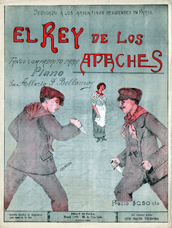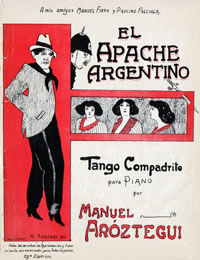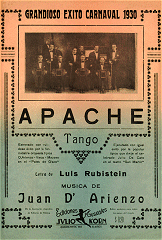By
El apache argentino - A Redskin tango, “El apache argentino”

pache was the name of an Indian nation in the south of the United States of America. And during the last wars of those Redskin warriors against the United States army that little word spread worldwide.
 So much insisted the papermen in the names of the Apache chiefs who led the uprising that the underworld gangsters of Paris adopted sobriquets like Cochise, Jerónimo, Manuel, Sitting Bull or Crazy Horse, to mention some examples despite the last two were not Apache but Sioux. Consequently, the French papers Le Matin of Paris and Le Journal began to name the criminals of the French capital city as Apaches.
So much insisted the papermen in the names of the Apache chiefs who led the uprising that the underworld gangsters of Paris adopted sobriquets like Cochise, Jerónimo, Manuel, Sitting Bull or Crazy Horse, to mention some examples despite the last two were not Apache but Sioux. Consequently, the French papers Le Matin of Paris and Le Journal began to name the criminals of the French capital city as Apaches.
Time later on May 17, 1912 the well-remembered journalist Juan José de Soiza Reilly published an article entitled: Buenos Aires tenebroso. Los apaches in the Fray Mocho magazine.
 It was the historian from Rosario, Héctor Nicolás Zinni, who collected and let us know those strange lines. Soiza Reilly said:
It was the historian from Rosario, Héctor Nicolás Zinni, who collected and let us know those strange lines. Soiza Reilly said:
«—“Do you want to see the Apaches?”, a busy police chief of the investigation bureau asked me.
“—Apaches? Do they exist in Buenos Aires?".
“—There are many. Gradually they’re getting used to us. They slowly introduce their barbarian habits into our city... They argue, play, steal, fight, kill, murder. They use the Parisian slang in the foreign land».
Zinni adds that the note furthermore shows photographs of the so called Apaches reunited inside and outside different cafes located in the downtown Buenos Aires.
 Because of that in the 10s several tangos that mentioned in its titles those characters appeared: “El apache” by Mauricio Mignot; “El apache porteño” by Luis Bernstein in 1913, recorded by his brother Arturo for Atlanta records; “El rey de los apaches”, by Alberto Bellomo, dedicated to the Argentine people living in Paris; “Apache uruguayo” by Francisco Baldomir, that won the first prize of the Tango Contest organized by the Casino of Montevideo in 1914; “El apache oriental” by Enrique Delfino, in 1912; “El apache rosarino” by Federico Gallo; “El apache argentino [b]” by Celestino Reynoso Basavilbaso and the one with the same name and, definitively, the most renowned, by Manuel Aróztegui, in 1913. Thereafter, for the carnival balls of 1930 Juan D'Arienzo’s “Apache” was premiered.
Because of that in the 10s several tangos that mentioned in its titles those characters appeared: “El apache” by Mauricio Mignot; “El apache porteño” by Luis Bernstein in 1913, recorded by his brother Arturo for Atlanta records; “El rey de los apaches”, by Alberto Bellomo, dedicated to the Argentine people living in Paris; “Apache uruguayo” by Francisco Baldomir, that won the first prize of the Tango Contest organized by the Casino of Montevideo in 1914; “El apache oriental” by Enrique Delfino, in 1912; “El apache rosarino” by Federico Gallo; “El apache argentino [b]” by Celestino Reynoso Basavilbaso and the one with the same name and, definitively, the most renowned, by Manuel Aróztegui, in 1913. Thereafter, for the carnival balls of 1930 Juan D'Arienzo’s “Apache” was premiered.
 Curiously, some of the titles had coincidences. But the only that lasted and is one of the greatest classics of the genre is the one composed by Aróztegui whose recording by Juan Maglio Pacho in 1913 turned out a boom. Later lyrics were added by Arturo Mathon —that recorded it that year— and, later, by Carlos Waiss, for the movie La cumparsita directed by Antonio Momplet in 1947.
Curiously, some of the titles had coincidences. But the only that lasted and is one of the greatest classics of the genre is the one composed by Aróztegui whose recording by Juan Maglio Pacho in 1913 turned out a boom. Later lyrics were added by Arturo Mathon —that recorded it that year— and, later, by Carlos Waiss, for the movie La cumparsita directed by Antonio Momplet in 1947.
But “El apache argentino” remained as an instrumental. It was a tango to be played «by a bandoneon covered by laurels», according to the suitable words of Joaquín Gómez Bas.
Some renditions of “El apache argentino”:
Orquesta Juan Maglio Pacho - (1913)
Arturo Mathon with orchestra - (1913)
Orquesta Juan D'Arienzo - (1944)
Orquesta Adolfo Pérez Pocholo - (1948)
Orquesta Francini-Pontier - (1949)
Cuarteto Roberto Firpo - (1953)
Quinteto Pirincho Dir: Francisco Canaro - (1955)
Orquesta Donato Racciatti
Orquesta Alfredo De Angelis - (1969)
Orquesta Florindo Sassone - (1974)
Conjunto Rafael Rossi - (1977)
Cuarteto Oscar Bozzarelli - (1982)
Conjunto del Novecientos Dir: Victor De Paz
Los Muchachos de Antes
Guitar solo by Conrado López Torres - (1989)
Piano solo by Ariel Ramírez
Juanjo Domínguez Guitar Group - (1999)
Quinteto Los Taitas
Quinteto José Libertella
Guitar solo by Fernando Javier González - (2004)
Orquesta Érica Di Salvo - (2004)